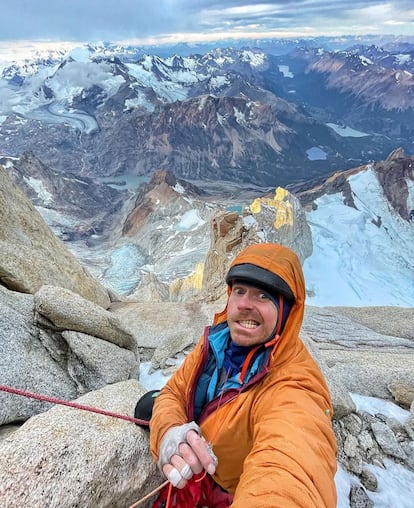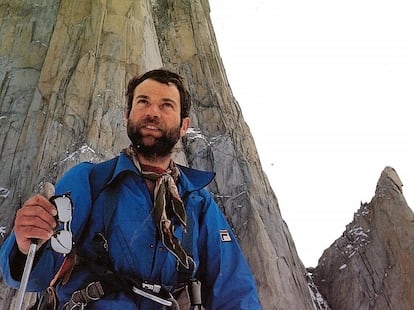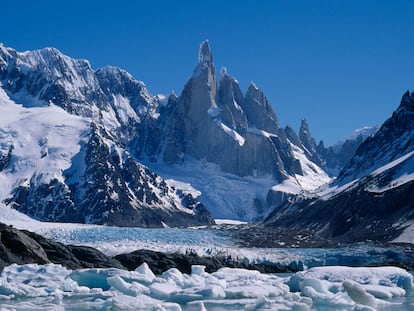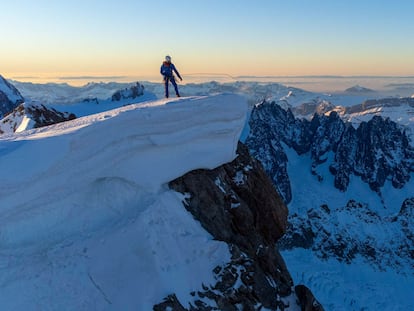Colin Haley: When love is your climbing partner
The American alpinist makes a solo ascent of the Goretta Pillar in Patagonia and pays homage to Italian mountaineering legend Renato Casarotto who named the rock ridge for his wife, Goretta Traverso

Some alpinists choose a climbing partner, and the relationship becomes a marriage bonded by absolute trust. Others jump from partner to partner, depending on circumstances and needs, their choices driven by the single-minded pursuit of a goal. Then there are those who choose to climb alone, like Italian mountaineer Renato Casarotto. His name means little to younger generations, except to those who are steeped in the lore of rock climbing – people like Colin Haley. The American climber has spent so much time in Patagonia that he could be a candidate for honorary Argentinian citizenship. Haley lives in El Chaltén, a village within Los Glaciares National Park in Argentina’s Santa Cruz province. The village is a gateway to trails surrounding the peaks of Cerro Torre and Mount Fitz Roy to the northwest.
Haley’s latest solo ascent is a tribute to the memory of Renato Casarotto (1948-1986). Like Casarotto, Haley is at his best in his solace, immersed in inner monologues, harboring hopes expressed to no one. This is how he made the first solo ascent of the Torre Egger, one of the mountains of the Southern Patagonian Ice Field. Last year, Haley made the first winter solo ascent of the Mount Fitz Roy via the Supercanaleta couloir. But he also does well with experienced climbing partners like Alex Honnold, with whom he conquered the Cerro Torre mountain chain in just 20 hours and 40 minutes in 2016. Haley, who is sponsored by Patagonia and Scarpa, posted on social media, “Renato Casarotto was, in my opinion, one of the most impressive alpinists of all time and a great source of inspiration for me.”
The north ridge of Fitz Roy has a huge rock pillar that juts upward like a spear. It was dubbed the Goretta Pillar by Casarotto after he made the first ascent of the 4,000-foot (1,200 meters) pillar in 1979. He faced the climb alone, with nothing more than the moral support of his wife, Goretta Traverso, who accompanied Casarotto on almost every expedition. Goretta was also a rock and ice climber, but never wanted to be defined as a mountaineer. Their love story transcended the cliché of a great woman behind every great man. Goretta was the source of her husband’s great successes, experiences that they shared as complete equals. “He named the pillar in honor of his wife, and even if he had to use a rope on the first ascent, it’s still an incredible achievement for the time. It also strikes me as one of the most beautiful ascents ever,” wrote Haley, just days after completing the first alpine-style solo ascent of the legendary pillar.
Goretta was the perfect climbing partner, a powerful presence even while waiting for her husband in a base camp. With Goretta’s spirit by his side, Casarotto found the strength to take on challenges, face up to his failures, understand his aspirations and motivations and stare down the most intimidating obstacles. Many felt that Casarotto only climbed for his wife and through his wife. Not long after he conquered and named the Goretta Pillar, Casarotto experienced one of his greatest disappointments with another mountaineer – none other than the mighty Reinhold Messner. Chosen for a powerful team that aimed to conquer the unvanquished Magic Line, a dangerous route up K2, the world’s second-highest mountain, Casarotto was anxious to take on the challenge. But Messner was in charge, and after studying the route, he decided that the undertaking was madness. He refused to even attempt the Magic Line and set off on the normal route. Casarotto went berserk and called Messner’s decision an act of cowardice. Messner publicly took him to task in the news media.

But the Magic Line wouldn’t leave Casarotto alone, and he obsessed for years about making the climb. He prepared for a 1986 return to K2 by climbing alone, but always using ropes. In the winter of 1982, carrying a heavy backpack with climbing gear, food and a tent, he approached the south face of Mont Blanc along the French-Italian border. His goal was to make three solo ascents of its most difficult routes. To complete the trio, Casarotto chose the remote and intimidating Frêney slope, where the famous Central Pillar is located. He returned victorious to Chamonix two weeks later. Next, he prepared for extreme altitudes by ascending Gasherbrum II on the Pakistani-Chinese border in 1985, accompanied by Goretta who became the first Italian woman to reach the summit of an 8,000-meter (25,000 feet) mountain. Casarotto was now ready to take on the Magic Line.
Colin Haley says he dreamed for 10 years about making a solo ascent of the Goretta Pillar. To be successful, he would have to change his usual fast-paced climbing style. Almost all of his great Patagonian ascents have been non-stop – no bivouacs, sleeping bag or tent. But he wouldn’t be able to move that fast on the Goretta Pillar, so he spent the summer in Chamonix practicing self-roping techniques. On January 17, Haley began the slow and arduous maneuver along the 4,000-foot (1,200 meters) wall of the Goretta Pillar, and completed the climb two days later. “I self-roped 97% of the route and only climbed the last 650 feet (200 meters) of easy terrain without a rope. It was a way of avoiding the mental intensity of climbing without ropes, but the safer approach was terribly arduous and physically exhausting,” said Haley. To self-belay, one has to climb with a length of rope, anchor it safely, rappel down and then climb back up using the fixed rope line. In other words, the route has to be climbed twice carrying a pack full of bivouac equipment, food, gas, stove, etc. “It was a huge challenge, and I’m very proud of it,” he said.
Renato Casarotto came very close to fulfilling his dream. In the summer of 1986, he made it almost all the way up K2′s Magic Line, falling just 1,300 feet (400 meters) short on two attempts. He abandoned a third attempt due to bad weather when he was less than 1,000 feet (300 meters) from the top. As Casarotto approached the base camp, a snow bridge gave way and he fell in a crevasse. Kurt Diemberger watched him disappear through a telescope and asked Goretta to turn on the radio. Immediately they heard a terse message: “I’m dying at the bottom of a crevasse.” He was rescued alive, but soon succumbed to severe internal injuries. Goretta decided to bury him in the crevasse. It was a terrible season for K2 climbers – 13 died that year. Casarotto did not live to see a Polish team complete the Magic Line ascent later that summer. Spanish climber Jordi Corominas made the first and only solo climb of the Magic Line in 2004. Corominas and his team later found Casarotto’s remains, which had been returned to the surface by the same glacier that swallowed him 18 years earlier. When Goretta heard the news, she decided to inter her late husband at the Gilkey Memorial, a tomb near the K2 base camp for those who died climbing the mountain.
Sign up for our weekly newsletter to get more English-language news coverage from EL PAÍS USA Edition
Tu suscripción se está usando en otro dispositivo
¿Quieres añadir otro usuario a tu suscripción?
Si continúas leyendo en este dispositivo, no se podrá leer en el otro.
FlechaTu suscripción se está usando en otro dispositivo y solo puedes acceder a EL PAÍS desde un dispositivo a la vez.
Si quieres compartir tu cuenta, cambia tu suscripción a la modalidad Premium, así podrás añadir otro usuario. Cada uno accederá con su propia cuenta de email, lo que os permitirá personalizar vuestra experiencia en EL PAÍS.
¿Tienes una suscripción de empresa? Accede aquí para contratar más cuentas.
En el caso de no saber quién está usando tu cuenta, te recomendamos cambiar tu contraseña aquí.
Si decides continuar compartiendo tu cuenta, este mensaje se mostrará en tu dispositivo y en el de la otra persona que está usando tu cuenta de forma indefinida, afectando a tu experiencia de lectura. Puedes consultar aquí los términos y condiciones de la suscripción digital.
More information
Últimas noticias
The complicated life of Francesca Albanese: A rising figure in Italy but barred from every bank by Trump’s sanctions
Half of Scotland is in the hands of 420 property owners
Reinhard Genzel, Nobel laureate in physics: ‘One-minute videos will never give you the truth’
Pinochet’s victims grapple with José Antonio Kast’s rise in Chile
Most viewed
- Pablo Escobar’s hippos: A serious environmental problem, 40 years on
- Why we lost the habit of sleeping in two segments and how that changed our sense of time
- Charles Dubouloz, mountaineering star, retires at 36 with a farewell tour inspired by Walter Bonatti
- Reinhard Genzel, Nobel laureate in physics: ‘One-minute videos will never give you the truth’
- The Florida Keys tourist paradise is besieged by immigration agents: ‘We’ve never seen anything like this’











































